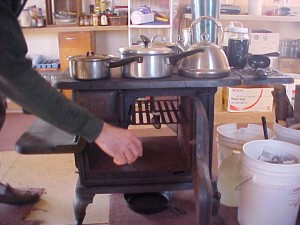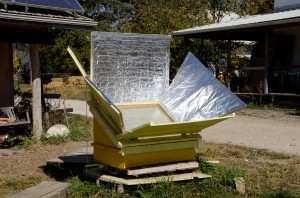Food Preparation, Processing and Storage Methods
Cooking
When it comes to food, most of the ecological impact (see our page on local foods) comes from production, shipping, processing, marketing, and storage rather than cooking, but cooking is still something we make serious efforts to do efficiently.
As with other resource use, in cooking conservation comes first. Many of us eat cooperatively, sharing cooking and cleaning tasks and eating together in groups from 3 to 30. This reduces the number of kitchens we need as well as all the refrigerators, stoves, and other appliances. It also allows for more efficient cooking assuming you are careful not to waste food.
People at DR are experimenting with ways to prepare food that use minimal energy and water, and no fossil fuels, taste great, and take a reasonable amount of time. Several members use wood fired rocket stoves that require much less wood than a conventional wood stove for producing heat for cooking. Many people also rely on solar ovens, free-standing ovens with solar reflectors positioned in the sun to reflect light into the oven box, for baking during sunny weather. We have two large-capacity custom solar ovens for shared use that are utilized by individuals and food co-ops. Another useful technology is the haybox–simply an insulated box–to complete cooking at a somewhat slower rate using much less energy. While we still use propane in most of our kitchens at Dancing Rabbit our long term goal is to phase out its use.
Food Storage
Processing and storing food is a large part of growing our own gardens and utilizing the available native or local sources of food on our land. During summer and fall you may find many people here drying, canning, and fermenting all manner of food. We use solar and electric dehydrators for drying fruits, herbs, and vegetables. Stovetop canning is an essential for individuals and co-ops who rely on preserved fruits and vegetables rather than importing out of season produce. Fermented foods are another nutritious and interesting food experiment that has been embraced here. DR’s land has several wild edibles that provide plentiful fodder for preservation including mulberries, cattail shoots, wild plums, and wild grapes to name a few. Have you ever tried a fermented milkweed pod?
We have no walk-in refrigerators or freezers for storing large quantities of perishable foods at DR, so fridge space in larger co-ops is reserved mainly for fresh vegetables, dairy, and leftovers. Members use extremely efficient appliances for providing refrigeration, while a few take it a step further and do without refrigeration completely. Some members have root cellars and root barrels for winter crop storage. During mild winters, gardeners may even choose to store crops directly in their garden rows as some plants can over-winter if mulched and do just fine in the cold, like leeks!



